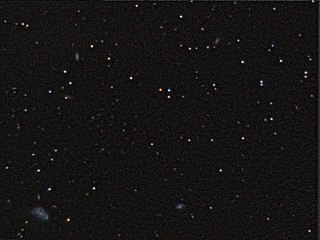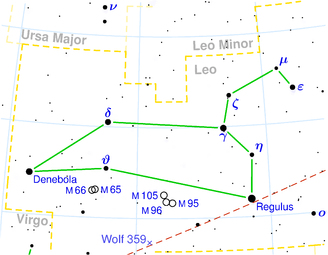Wolf 359
|
Stern Wolf 359 (CN Leonis) |
|||||||
|---|---|---|---|---|---|---|---|

|
|||||||
| Amateur shot of the star field with Wolf 359 (the striking red star slightly above the center of the image) | |||||||
| AladinLite | |||||||
|
Observation dates equinox : J2000.0 , epoch : J2000.0 |
|||||||
| Constellation | lion | ||||||
| Right ascension | 10 h 56 m 28.8 s | ||||||
| declination | + 07 ° 00 ′ 52 ″ | ||||||
| Apparent brightness | 13.51 mag | ||||||
| Typing | |||||||
| rel. Brightness (J-band) |
(7.09 ± 0.02) mag | ||||||
| Known exoplanets | 2 | ||||||
| B − V color index | +2.03 | ||||||
| U − B color index | +1.17 | ||||||
| R − I index | +2.18 | ||||||
| Spectral class | M6.5 Ve | ||||||
| Variable star type | UV | ||||||
| Astrometry | |||||||
| Radial velocity | (19.32 ± 0.15) km / s | ||||||
| parallax | (415.16 ± 1.62) mas | ||||||
| distance | (7.78 ± 0.04) ly (2.39 ± 0.01) pc |
||||||
| Visual absolute brightness M vis | (+16.69) mag | ||||||
| Proper movement | |||||||
| Rec. Share: | (−3808.09 ± 0.30) mas / a | ||||||
| Dec. portion: | (−2692.61 ± 0.42) mas / a | ||||||
| Physical Properties | |||||||
| Dimensions | 0.09 M ☉ | ||||||
| radius | 0.16 R ☉ | ||||||
| Luminosity |
(0.001) L ☉ |
||||||
| Effective temperature | (2800 ± 100) K. | ||||||
| Rotation time | 24 hours | ||||||
| Age | 100 to 400 mill. A | ||||||
|
Other names and catalog entries |
|||||||
|
|||||||
Wolf 359 is a red dwarf in the constellation Leo . At a distance of about 7.8 light years , it is the fifth closest star to the solar system . Nevertheless, Wolf 359 cannot be seen with the naked eye because of its low brightness. The star was only discovered in 1918 by the German astronomer Max Wolf using astrophotography and named in a star catalog he published.
description
Wolf 359 is one of the faintest shining stars known to date. With around 10 percent of the solar mass, it is a borderline case between a brown and a red dwarf . Its core temperature was only just enough to start a nuclear fusion of hydrogen to helium and to generate energy from it.
As an extreme red dwarf of the M6 spectral type , the star glows dark red. Wolf 359 tends to have irregular bursts in which its brightness increases sharply for a short time. This property is typical of many red dwarfs, so this type is also known as a flare star . As a variable star , Wolf 359 is called CN Leonis .
Planetary system
In 2019 the possible discovery of 2 planets around Wolf 359 using the radial velocity method was announced. The study combined the data gathered over the years from several Échelle spectrographs . The inner planet Wolf 359 c is already outside the habitable zone despite a distance of only 0.018 AU . The outer planet Wolf 359 b is much further out with about 1.8 AU and due to the low luminosity of Wolf 359 it hardly receives any more energy from the star.
Because of its low luminosity, the habitable zone around Wolf 359 is very close to the star. A hypothetical planet with liquid water would have to orbit Wolf 359 in only 0.004 AU (628,000 km). That is less than twice the distance from the earth to the moon. The result would be a bound rotation and orbiting the star would only take around eight hours at this distance. Planets at a greater distance would be too cold for liquid water.
| planet |
Discovered |
Mass ( earth masses ) |
Radius ( earth radii ) |
Major semiaxis of the railway ( AU ) |
Rotation time ( days ) |
eccentricity |
|---|---|---|---|---|---|---|
| Wolf 359 b | 2019 | 43.5 +29.5−23.9 | - | 1.845 +0.289−0.258 | 2938 ± 436 | 0.04 +0.27−0.04 |
| Wolf 359 c | 2019 | 3.8 +2.0−1.6 | - | 0.018 ± 0.002 | 2.69 ± 0.01 | 0.15 +0.20−0.15 |
Visual observation
Wolf 359 is quite easy to find just below the Leo constellation. The strikingly red, 5.8 mag bright star 56 Leonis can serve as a guide. Wolf 359 is 50 arc minutes north of it.
Wolf 359 is so faint that it can only be seen in a larger instrument with a diameter of 35 cm or more. Visual observation is hardly possible in smaller instruments.
Mention in science fiction
- In the Star Trek universe, Wolf 359 is the scene of a crushing defeat of the Federation against the Borg , to which reference is made in later episodes, series, films and games.
- In the computer game Freespace , a Terran fleet is stationed at Wolf 359. A transfer there is only mentioned in the case of penalties for failed missions.
- In the novel Chindi by Jack McDevitt Wolf 359 is mentioned as a goal of the second interstellar journey of humanity.
- In the novel The Collapse (Volume 1 of the series Die Nanokriege ) by John Ringo , a larger terraforming project takes place at Wolf 359 .
- In the novel The Red Fog (1979) from the science fiction series about the character of Commander Perkins ( Franz Schneider Verlag ), the earth is threatened by a red fog that transports Wolf 359 from the eighth planet of the sun to earth with the help of the dimension breaker becomes.
- In the radio play Planetaktion Z of the Mark Brandis science fiction series , a rescue maneuver is flown towards Wolf 359.
See also
Web links
- Nearby stars - images and detailed data
- Further recordings, observations and information on Wolf 359
- The Wolf 359 movement since March 2006
Individual evidence
- ↑ a b c d e f g h Wolf 359. In: SIMBAD . Center de Données astronomiques de Strasbourg , accessed June 15, 2019 .
- ↑ a b c M. Tuomi, HRA Jones, G. Anglada-Escudé, RP Butler, P. Arriagada, SS Vogt, J. Burt, G. Laughlin, B. Holden, JK Teske, SA Shectman, JD Crane, I. Thompson, S. Keizer, JS Jenkins, Z. Berdiñas, M. Diaz, M. Kiraga, JR Barnes: Frequency of planets orbiting M dwarfs in the solar neighborhood . In: arxiv . 2019. arxiv : 1906.04644 .
- ↑ a b Wolf 359 b. In: Extrasolar Planets Encyclopaedia . Retrieved June 15, 2019 .
- ↑ a b CN Leo. In: VSX. AAVSO , accessed November 10, 2018 .
- ^ A b c Cassy L. Davison, RJ White, TJ Henry, AR Riedel, W.-C. Jao, JI Bailey, SN Quinn, JR Cantrell, JP Subasavage, JG Winters: A 3D Search for Companions to 12 Nearby M Dwarfs . In: The Astronomical Journal . 149, No. 3, 2015, p. 106. arxiv : 1501.05012 . bibcode : 2015AJ .... 149..106D . doi : 10.1088 / 0004-6256 / 149/3/106 .
- ↑ a b c Ya. V. Pavlenko, HRA Jones, Yu. Lyubchik, J. Tennyson, DJ Pinfield: Spectral energy distribution for GJ406 . In: Astronomy & Astrophysics . 447, No. 2, 2006, pp. 709-717. arxiv : astro-ph / 0510570 . bibcode : 2006A & A ... 447..709P . doi : 10.1051 / 0004-6361: 20052979 .
- ↑ M. Wolf: Two stars with great proper motion in Leo. Astronomische Nachrichten, Volume 206 (1918), Issue 24, No. 4944, p. 237 (there star No. 699), bibcode : 1918AN .... 206..237W
- ^ M. Wolf: Catalog of 1053 more strongly moved fixed stars. Publications of the Baden Observatory in Heidelberg, Volume 7 (1919), No. 10, 195–219, bibcode : 1919VeHei ... 7..195W
